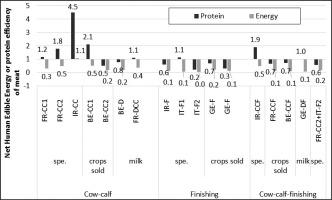Agricultural Systems ( IF 6.6 ) Pub Date : 2021-02-09 , DOI: 10.1016/j.agsy.2021.103088 Mosnier Claire , Jarousse Anne , Madrange Pauline , Balouzat Jimmy , Guillier Maëva , Pirlo Giacomo , Mertens Alexandre , ORiordan Edward , Pahmeyer Christoph , Hennart Sylvain , Legein Louise , Paul Crosson , Kearney Mark , Dimon Philippe , Bertozzi Carlo , Reding Edouard , Iacurto Miriam , Breen James , Carè Sara , Veysset Patrick

|
Context
Livestock production, and more particularly ruminants, is criticized for its low conversion efficiency of natural resources into edible food.
Objective
The objectives of this paper are to propose an evaluation of the contribution to food security of different European cattle farms through three criteria: 1) food production assessed by the amount of human-edible protein (HEP) and energy (HEE) produced at farm level, 2) feed-food competition at the beef production scale estimated in terms of net human-edible protein and energy and in terms of land used, and 3) food affordability assessed by the production cost of meat, protein and energy.
Methods
The analysis is based on 16 representative beef production systems in France, Belgium, Ireland, Italy and Germany and covers cow-calf systems, finishing systems, dairy and mixed dairy- finishing systems, with or without cash crops.
Results and conclusions
The results show that, at the farm level, systems producing both beef and milk or cereals have higher HEP and HEE production per hectare (up to 370 kg of HEP and 60,000 106J.ha−1) than specialized beef systems (up to 50 kg of HEP and 1600 106J.ha−1) and have lower production costs (approximately €6 kg−1 of HEP in mixed beef system and €29 kg−1 of HEP in a specialized cow-calf-fattener system). Beef systems are almost all HEE net consumers. Results are more variable concerning net HEP efficiency. The cow-calf enterprises are mostly net producers of HEP but, in order to produce human edible meat, these systems need to be combined with finishing systems that are mostly net consumers of HEP. In most cases, cow-calf-finishing systems are net consumers of HEP (between 0.6 and 0.7) but grass-based systems using very little concentrates or systems using co-products not edible by humans are net HEP producers. The grass-based systems use more land area per kilogram of carcass but a major part of this area is non-tilled land, thus these systems are not in direct competition with human food production. The lowest meat production costs are the finishing systems producing the most live weight per livestock unit (LU) per year and dairy systems in lowland which share the costs between milk and meat.
Significance
Although most of HEE and HEP efficient farms typically have higher meat production costs, some grassland based systems stand out positively for all indicators. These results pave the way for improvements of the contribution of beef production systems to food security.
中文翻译:

评估16种欧洲牛肉生产系统对粮食安全的贡献
语境
畜牧生产,特别是反刍动物的生产因其将自然资源转化为可食用食品的效率低而受到批评。
目的
本文的目的是通过三个标准提出对不同欧洲养牛场对粮食安全的贡献的评估:1)通过农场水平生产的人类可食用蛋白质(HEP)和能量(HEE)的数量评估粮食生产; 2)牛肉生产规模上的饲料-食品竞争,根据人类可食用的蛋白质和能量的净值以及所使用的土地来估算,以及3)通过肉,蛋白质和能量的生产成本评估的食品承受能力。
方法
该分析基于法国,比利时,爱尔兰,意大利和德国的16种代表性牛肉生产系统,涵盖了有或没有经济作物的牛犊系统,育肥系统,乳制品和混合乳制品育种系统。
结果与结论
结果表明,在农场一级,生产牛肉,牛奶或谷物的系统每公顷的HEP和HEE产量(最多370公斤HEP和60,000 10 6 J.ha -1)要比专用牛肉系统(最高50公斤HEP和1600 10 6 J.ha -1),生产成本较低(混合牛肉系统中约6公斤-1 HEP,29公斤-1欧元)在专门的牛犊牛化肥系统中使用HEP)。牛肉系统几乎是所有HEE的净消费者。关于净HEP效率,结果更具可变性。牛犊企业主要是HEP的净生产者,但是,为了生产人类食用肉,需要将这些系统与主要是HEP净消费者的精加工系统结合使用。在大多数情况下,牛犊育肥系统是HEP的净消费者(0.6至0.7),但使用很少浓缩物的草基系统或使用人类不能食用的副产品的系统是HEP净生产者。以草为基础的系统每公斤of体使用更多的土地面积,但是该区域的主要部分是非耕地,因此这些系统与人类粮食生产没有直接竞争。
意义
尽管大多数具有HEE和HEP效率的农场通常具有较高的肉类生产成本,但一些基于草原的系统在所有指标上都表现突出。这些结果为改善牛肉生产系统对粮食安全的贡献铺平了道路。


























 京公网安备 11010802027423号
京公网安备 11010802027423号